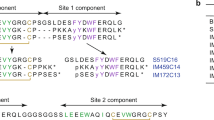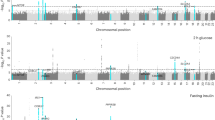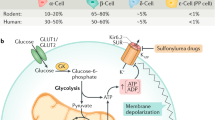Abstract
At least three different glucose transport systems exist in mammalian cells. These are: (1) the constitutively active, facilitative carrier characteristic of human erythrocytes1, Hep G2 (ref. 2) cells and rat brain3; (2) the Na-dependent active transporter of kidney and small intestine4,5; and (3) the facilitative carrier of rat liver (B. Thorens and H. F. Lodish, personal communication). A fourth possible glucose transport system is the insulin-dependent carrier that may be specific to muscle and adipose tissue6. This transporter resides primarily in an intracellular compartment in resting cells from where it translocates to the cell surface upon cellular insulin exposure7–9. This raises the question of whether hormonal regulation of glucose transport is conferred by virtue of a tissue-specific signalling mechanism or a tissue-specific glucose transporter. Here we present data supporting the latter concept based upon a monoclonal antibody against the fat cell glucose transporter that identifies a unique, insulin-regulatable glucose transport protein in muscle and adipose tissue.
This is a preview of subscription content, access via your institution
Access options
Subscribe to this journal
Receive 51 print issues and online access
$199.00 per year
only $3.90 per issue
Buy this article
- Purchase on Springer Link
- Instant access to full article PDF
Prices may be subject to local taxes which are calculated during checkout
Similar content being viewed by others
References
Jung, C. in The Red Blood Cell, Vol. II (ed. Surgenor, D. M.) 705–751 (Academic, New York, 1975).
Mueckler, M. et al. Science 229, 941–945 (1985).
Birnbaum, M. J., Haspel, H. C. & Rosen, O. M. Proc. natn. Acad. Sci. U.S.A. 83, 5784–5788 (1986).
Wu, J.-S. R. & Lever, J. E. Biochemistry 26, 5958–5962 (1987).
Hediger, M. A., Coady, M. J., Ikeda, T. S. & Wright, E. M. Nature 330, 379–381 (1987).
Elbrink, J. & Bihler, I. Science 188, 1177–1184 (1975).
Cushman, S. W. & Wardzala, L. J. J. biol. Chem. 255, 4758–4762 (1980).
Suzuki, K. & Kono, T. Proc. natn. Acad. Sci. U.S.A. 77, 2542–2545 (1980).
Blok, J., Gibbs, E. M., Lienhard, G. E., Slot, J. W. & Geuze, H.J. J. cell Biol. 106, 69–76 (1988).
Lienhard, G. E., Kim, H. H., Ransome, K. J. & Gorga, J. C. Biochem. biophys. Res. Commun. 105, 1150–1156 (1982).
Oka, Y. & Czech, M. P. J. biol. Chem. 259, 8125–8133 (1984).
James, D. E., Lederman, L. & Pilch, P. F. J. biol. Chem. 262, 11817–11824 (1987).
Shanahan, M. F., Olson, S. A., Weber, M. J., Lienhard, G. E. & Gorga, J. C. Biochem. biophys. Res. Commun. 107, 38–43 (1982).
Wheeler, T. J., Simpson, I. A., Sogin, D. C., Hinkle, P. C. & Cushman, S. W. Biochem. biophys. Res. Commun. 105, 89–95 (1982).
Haspel, H. C., Birnbaum, M. J., Wilk, E. W. & Rosen, O. M. J. biol. Chem. 260, 7219–7225 (1985).
Shanahan, M. F. J. biol. Chem. 257, 7290–7293 (1982).
Pessin, J. E. et al. Proc. natn. Acad. Sci. U.S.A. 79, 2286–2290 (1982).
Simpson, I. A. & Cushman, S. W. A. Rev. Biochem. 55, 1059–1089 (1986).
Wang, C. J. biol. Chem. 262, 15689–15695 (1987).
Haspel, H. C., Rosenfeld, M. G. & Rosen, O. M. J. biol. Chem. 263, 398–404 (1988).
Joost, H. G., Weber, T. M. & Cushman, S. W. Biochem. J. 249, 155–161 (1988).
Taylor, L. P. & Holman, G. D. Biochim. biophys. Acta 642, 325–335 (1981).
Holman, G. D. & Rees, W. D. Biochim. biophys. Acta 685, 78–86 (1982).
Horuk, R., Matthei, S., Olefsky, J. M., Baly, D., Cushman, S. W. & Simpson, I. A. J. biol. Chem. 261, 1823–1828 (1986).
Kimmich, G. A. & Randle, J. Am. J. Physiol. 241, C227–C232 (1981).
Breitbart, R. E., Andreadis, A. & Nadal-Ginard, B. A. Rev. Biochem. 56, 467–495 (1987).
Laemmli, U. K. Nature 227, 680–685 (1970).
Galfre, G. & Milstein, C. Meth. Enzym. 73, 3–46 (1981).
Wessling, M. & Pilch, P. F. Biochim. biophys. Acta 777, 123–132 (1984).
Author information
Authors and Affiliations
Rights and permissions
About this article
Cite this article
James, D., Brown, R., Navarro, J. et al. Insulin-regulatable tissues express a unique insulin-sensitive glucose transport protein. Nature 333, 183–185 (1988). https://doi.org/10.1038/333183a0
Received:
Accepted:
Issue Date:
DOI: https://doi.org/10.1038/333183a0
This article is cited by
-
A transporter on the move
Nature Reviews Endocrinology (2024)
-
What can we learn about acid-base transporters in cancer from studying somatic mutations in their genes?
Pflügers Archiv - European Journal of Physiology (2023)
-
Dominant-negative p53-overexpression in skeletal muscle induces cell death and fiber atrophy in rats
Cell Death & Disease (2022)
-
Glucose transporter 2 in common carp (Cyprinus carpio L.): molecular cloning, tissue expression, and the responsiveness to glucose, insulin, and glucagon
Fish Physiology and Biochemistry (2020)
-
Fructose and prostate cancer: toward an integrated view of cancer cell metabolism
Prostate Cancer and Prostatic Diseases (2019)
Comments
By submitting a comment you agree to abide by our Terms and Community Guidelines. If you find something abusive or that does not comply with our terms or guidelines please flag it as inappropriate.



